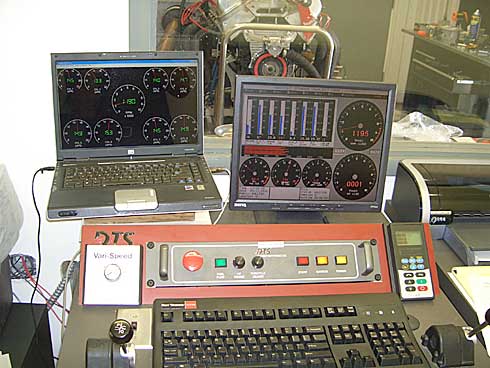Hidden Horsepower Found
Peering Into Fire in the Holes
By Mike Bumbeck
Photos Courtesy of Pedigo Performance and Innovate Motorsports
6/8/06

Looking inside a big block Chevy. The laptop at left is displaying real time individual cylinder air fuel ratios using an Innovate ST-12 and LogWorks software.
 fter 25 years in the auto repair business Tracy Pedigo thought it was time to retire and do something a little different and more closely related to his other occupation of sportsman drag racer. Since engine tuning and dyno-equipped shops were pretty scarce in his part of the world, he decided to put in a first class effort into starting one up. Stepping up to the trade involved getting the tools, and before you could say soapbox Tracy was standing up on his own about what using the latest tools of the engine-tuning world had enabled him to find. Pedigo Performance has quickly become known as the destination for squeezing the maximum amount of juice possible out of any given setup by being able find the ultimate jewel in the engine tuning treasure chest – hidden horsepower. These days Tracy has got it covered on water and on land tuning engines for the likes of Darell Wikle out on the 1320, and Duane Oblander over water.
fter 25 years in the auto repair business Tracy Pedigo thought it was time to retire and do something a little different and more closely related to his other occupation of sportsman drag racer. Since engine tuning and dyno-equipped shops were pretty scarce in his part of the world, he decided to put in a first class effort into starting one up. Stepping up to the trade involved getting the tools, and before you could say soapbox Tracy was standing up on his own about what using the latest tools of the engine-tuning world had enabled him to find. Pedigo Performance has quickly become known as the destination for squeezing the maximum amount of juice possible out of any given setup by being able find the ultimate jewel in the engine tuning treasure chest – hidden horsepower. These days Tracy has got it covered on water and on land tuning engines for the likes of Darell Wikle out on the 1320, and Duane Oblander over water.
A case in point was a professionally built 505 cubic inch drag boat big block Chevy that for some reason or another was an underperformer. Everything should have been right on, but was way off. Tracy's first move was to bolt it up to the DTS engine dyno and run a safe low rpm pull to see what was going on. Using a dual air-fuel ratio sensor bank-to-bank sampling of the air fuel ratios down at the collectors, he was able to see that things were a little lean. A look inside the race-prepped carburetor revealed a set of 95 jets already doing the job. A step up to 98 jets and another safe pull managed some more power, but still
registered a bit on the lean side with a bank-to-bank reading of air fuel ratios. One by one the variables were eliminated. First the fuel was replaced with some unleaded premium to eliminate the possibility of ethanol messing with the mix. Next was a step up to 100 jets. All vacuum sources were checked and double-checked. The next pull got the air fuel ratio closer, but still not where it should be."It had gotten down into the high 13's on air fuel ratio, but in my experience where we needed to be was in the 13.1 to 13.2 range," said Tracy.
Even though the motor was posting decent HP Tracy wasn't satisfied and still felt as if there was a problem, so he hooked up an Innovate ST-12 to monitor the air fuel ratio at each one of the cylinders.